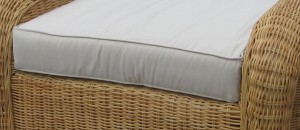Fixing wicker furniture: ‘Sturdy’ wood delicate
The recycling of tree trimmings into outdoor furniture is thought to have started in Europe in the mid-17th century. It lasted well into Victorian times, when more conventional outdoor furniture in durable woods of oak, ash and teak was mass-produced.
Today, reproductions of the simpler style are referred to as “roundwood” or “twig,” although more accurately, twig furniture is woven from willow. Technically, it could be called wicker. On both sides of the Atlantic, surviving pieces tend to be rather crudely constructed and have probably survived by the sheer sturdiness of the wood used – more branch than twig – and its ability to stand up to the weather.

In addition, in order to last, wicker furniture needed to be constructed with wooden pegs or nails to strengthen either a mortise and tenon joint or the simpler joint where one end of the member was slightly hollowed. In wicker furniture that was originally nailed together, the nails may have been replaced with wooden pegs. Rusting of the nails and rotting of the surrounding wood would have required replacements too thick and heavy to be practical.
This is why repairs to strengthen joints or make wicker furniture steadier should be carried out with suitably sized common dowel rods for pegs, rather than nails. Glue also may be used where parts fit together closely and accurately. But first, where old nails are present, they should be removed with pincers or pliers.
Disturb the surface wood as little as possible. Where this is difficult, you might try to drive the nails in with a nail set so that the emerging ends can be grabbed and pulled out from the other side. While the essence of rustic work is that it should look natural, there is no standard look for twig, so the choice is yours. For new wood, seek advice on a finish from the maker or vendor. For indoor use, an antique finish of the lowest luster varnish sits well and makes the wood easier to keep clean.